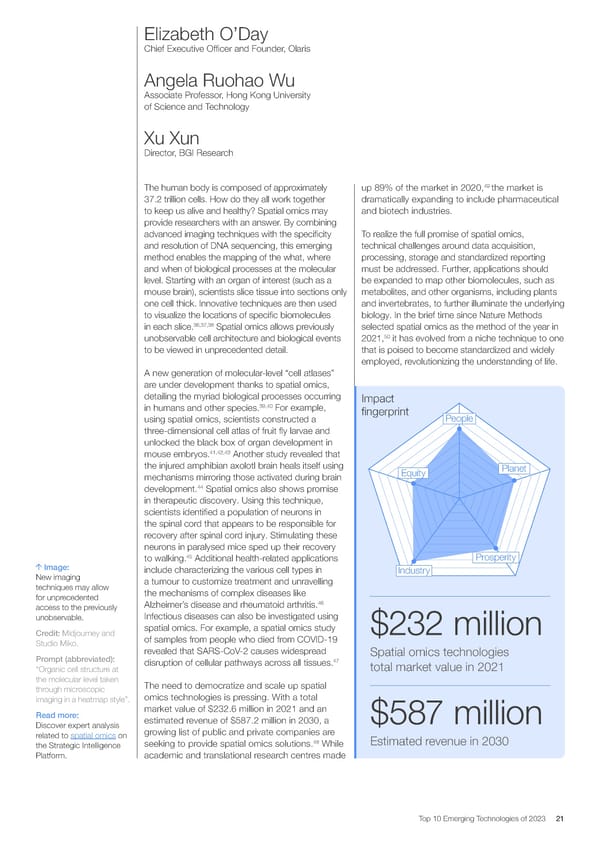Elizabeth O’Day Chief Executive Of昀椀cer and Founder, Olaris Angela Ruohao Wu Associate Professor, Hong Kong University of Science and Technology Xu Xun Director, BGI Research The human body is composed of approximately 49 the market is up 89% of the market in 2020, 37.2 trillion cells. How do they all work together dramatically expanding to include pharmaceutical to keep us alive and healthy? Spatial omics may and biotech industries. provide researchers with an answer. By combining advanced imaging techniques with the speci昀椀city To realize the full promise of spatial omics, and resolution of DNA sequencing, this emerging technical challenges around data acquisition, method enables the mapping of the what, where processing, storage and standardized reporting and when of biological processes at the molecular must be addressed. Further, applications should level. Starting with an organ of interest (such as a be expanded to map other biomolecules, such as mouse brain), scientists slice tissue into sections only metabolites, and other organisms, including plants one cell thick. Innovative techniques are then used and invertebrates, to further illuminate the underlying to visualize the locations of speci昀椀c biomolecules biology. In the brief time since Nature Methods 36,37,38 Spatial omics allows previously selected spatial omics as the method of the year in in each slice . 50 unobservable cell architecture and biological events 2021 , it has evolved from a niche technique to one to be viewed in unprecedented detail. that is poised to become standardized and widely employed, revolutionizing the understanding of life. A new generation of molecular-level “cell atlases” are under development thanks to spatial omics, detailing the myriad biological processes occurring Impact 39,40 in humans and other species . For example, 昀椀ngerprint using spatial omics, scientists constructed a People three-dimensional cell atlas of fruit 昀氀y larvae and unlocked the black box of organ development in 41,42,43 Another study revealed that mouse embryos. the injured amphibian axolotl brain heals itself using Equity Planet mechanisms mirroring those activated during brain 44 Spatial omics also shows promise development . in therapeutic discovery. Using this technique, scientists identi昀椀ed a population of neurons in the spinal cord that appears to be responsible for recovery after spinal cord injury. Stimulating these neurons in paralysed mice sped up their recovery 45 Additional health-related applications Prosperity to walking . Image: include characterizing the various cell types in Industry New imaging a tumour to customize treatment and unravelling techniques may allow the mechanisms of complex diseases like for unprecedented 46 access to the previously Alzheimer’s disease and rheumatoid arthritis . unobservable. Infectious diseases can also be investigated using Credit: Midjourney and spatial omics. For example, a spatial omics study $232 million Studio Miko. of samples from people who died from COVID-19 revealed that SARS-CoV-2 causes widespread Spatial omics technologies Prompt (abbreviated): 47 “Organic cell structure at disruption of cellular pathways across all tissues . total market value in 2021 the molecular level taken The need to democratize and scale up spatial through microscopic imaging in a heatmap style”. omics technologies is pressing. With a total Read more: market value of $232.6 million in 2021 and an Discover expert analysis estimated revenue of $587.2 million in 2030, a $587 million related to spatial omics on growing list of public and private companies are 48 While Estimated revenue in 2030 the Strategic Intelligence seeking to provide spatial omics solutions . Platform. academic and translational research centres made Top 10 Emerging Technologies of 2023 21
 Top 10 Emerging Technologies of 2023 Page 20 Page 22
Top 10 Emerging Technologies of 2023 Page 20 Page 22